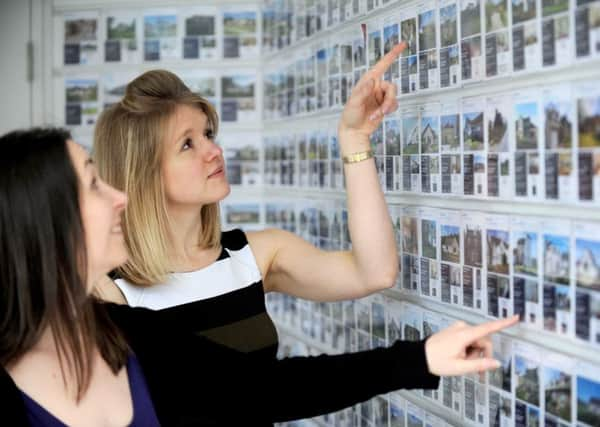Harder than ever to get a foothold on the ladder


The chances of would-be buyers in Scotland getting a foothold on the property ladder are receding further as a lack of affordable homes continues to support house prices.
The link between earnings and house prices in Scotland has weakened dramatically, according to new research showing that relatively affluent buyers are being priced out of the market in parts of the country.
Advertisement
Hide AdAdvertisement
Hide AdThe issue has been highlighted in the week of the SNP conference by a new GMB report on housebuilding in Scotland. “A massive programme to build more houses is absolutely essential”, the union warned after revealing that average house prices in parts of Scotland are up to almost eight times average earnings.
It found that workers on Scotland’s average earnings are priced out of the housing market in 21 of the 32 local authorities. The average house price in Scotland rose in the year to July by 3.4 per cent to £142,711, more than five times the average wage of £27,732 (as recorded by the Office for National Statistics).
Most banks and building societies lend at around 3.5 times salary, although an increase in the number of loans with an income multiple of 4.5 or more saw the Bank of England impose a “soft cap” earlier this year on lending above that level.
There are several local authorities in which even relatively affluent workers would struggle to afford the average home.
Average house prices in Edinburgh are 7.6 times average earnings, according to GMB Scotland, while East Lothian, Stirling, Perth and Kinross and Aberdeenshire all have multiples of 6.5 or higher.
The most affordable properties are in East and North Ayrshire, West Dunbartonshire, North Lanarkshire, Inverclyde, Renfrewshire and Falkirk.
Gary Smith, secretary of GMB Scotland, said: “These figures show that a massive programme to build more houses, especially houses for rent, by the local authorities is absolutely essential in all parts of Scotland and has to get under way without delay.
“We have been talking about this problem for far too long, there can be no excuses for not providing housing to people that they can afford to live in on average wages.”
Advertisement
Hide AdAdvertisement
Hide AdThe Royal Institution of Chartered Surveyors this week reported that house prices continue to rise north of the Border even as demand eases. It said 14 per cent more surveyors in Scotland predict further growth in house prices over the next three months than expect a decline.
The problem is that Scotland continues to suffer from a “serious lack of stock” across all tenures, said Dr John Boyle, head of research at Rettie & Co.
He pointed out that new build developments are still around a third below pre-2008 levels, which were already low.
“This shores up prices. With such limited stock, the buyers are now increasingly those in well above average incomes, probably top 30 per cent and above, hence the relationship between average earnings and average house price begins to break down because it is no longer those on average incomes buying average priced houses,” said Boyle.
Scotland urgently needs government and/or private funding to invest in land and infrastructure, said Boyle.
“We also need to encourage build-to-rent and provide rental units at affordable and open market levels,” he added. “This is the potential game changer as a lot of units can be delivered quickly, as there is little sales risk if you build rental units in the right place given the sheer scale of demand.”
While Holyrood is heading in that direction with proposals such as rental income guarantees, Boyle claims that tenancy reforms have undermined its efforts.
“The country needs to raise its game in house building across tenures otherwise it is going to continue to be pressured (in rents and sale prices) and people are going to struggle to find ,let alone afford, homes,” he said.
Advertisement
Hide AdAdvertisement
Hide AdThe latest warnings echo that issued in June 2015 by the Independent Commission on Housing and Wellbeing, which said Scotland’s “future wellbeing” was at risk unless the country embarked on a “dramatic increase” in housebuilding.
It called for 23,000 new homes a year to be built, including 9,000 affordable homes. But the number of new homes completed fell from 16,209 in 2014/15 to 15,854 in 2015/16, according to Scottish government data published in September.
Karen Campbell, director of policy at Homes for Scotland, said last month that the figure was “hugely disappointing” and called for “a return to pre-recession levels of building around 25,000 new homes a year by the end of this parliament”.